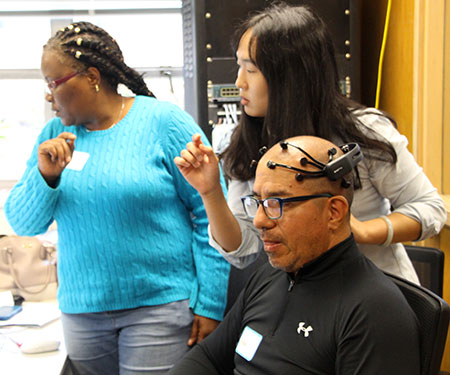
Researchers in NIU’s Department of Educational Technology, Research and Assessment are preparing to study whether – and how – readers respond differently to “hard” news reports and emotional stories.
Fatih Demir, an assistant professor of Instructional Technology, will use eye-tracking systems and brainwave monitors simultaneously to track the levels of engagement, excitement and stress in his test subjects as they read four purely informational articles and four stories written to tug at the heartstrings.
The experiment should offer Demir and his team – all graduate students in the program – with data not only on how the brain reacts to neutral versus emotional texts but, primarily, on how the two User Experience measurement tools work together.
It also will provide a best-practices blueprint for designers of instruction technology-based instruction.
“While we are creating an education module, do we need to keep emotional content to provide more engagement – or vice versa?” Demir asks.
“User Experience systems allow us to exactly understand what’s going on in the brains of our participants. Previously, without the advance of brainwave monitoring and eye-tracking systems, we relied on survey and observation, which might be biased. We’re now collecting pure data through the brain activities and eye-gaze movements,” he adds. “We will monitor how the brain activity changes while they are reading, mainly their emotions but also if their brain cognition increases or decreases.”
Some tech companies already sell “facial recognition systems,” for example, that analyze whether a person is happy or sad through facial expressions. One of those is among the tools in Demir’s kit.
NIU graduate students will participate in Phase One of the study, which begins in May and is a collaboration with the CREATE Center with support from Yanghee Kim and Michael Tscholl. The graduate students will read the collection of assigned texts while seated at computers.

Rockton Hononegah High School students, however, will read the news articles before and during physical activities at the Phase Two of the study this fall. Hononegah administrators are designing an “Experiment Class” for the study and actively engaging in the project.
Phase Three of the study is to develop high school curriculum in math education to boost learner engagement in the long term.
Graduate students on Demir’s research team are eager for the experience.
“We will understand better user attitudes,” says Sena Bulak, a native of Turkey who is pursuing her M.S.Ed. in Instructional Technology. “This opens the door to us to actually conduct our own research, and to change our own ways of interactions and product design.”
Excell Lewis, a Ph.D. candidate in Instructional Technology, expects to see more proof of the need for software designers – especially those in education – to think deeper.
“Their first thought is, ‘How can we deliver a product to the market?’ The second is user engagement,” says Lewis, who does believe that mindset is beginning to flip. “I’m personally interested to see how this changing trajectory will impact the future of artificial intelligence.”
Others in the group plan to translate these concepts for their colleagues back home.
 “I want to get more knowledge about it, and take this to my country to use it,” says Dalal Alfageh, a Ph.D. candidate in Instructional Technology from Saudi Arabia.
“I want to get more knowledge about it, and take this to my country to use it,” says Dalal Alfageh, a Ph.D. candidate in Instructional Technology from Saudi Arabia.
Wilson Hernandez, from Colombia, agrees. “I would be interesting to take this technology to our countries,” he says. “If we’re just starting here, can you imagine how it is in developing countries?”
Demir sees another benefit for his students. “Expanding their knowledge means a brighter future by conducting advanced research, producing more publications and getting better jobs,” he says.
“A lot of the tech companies in the Chicago area are seeking to understand User Experience better. Anyone can design anything, but they’re not sure if it’s working or not,” he adds. “In Educational research studies, deploying advanced UX technology is a new method, and these students will be starting one step ahead of their competition.”

